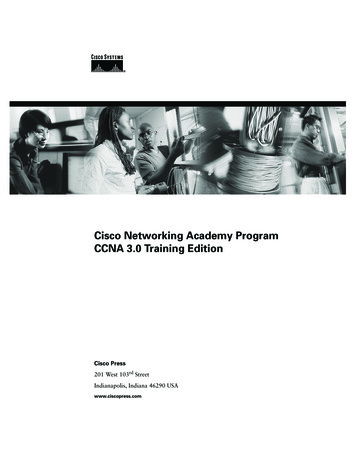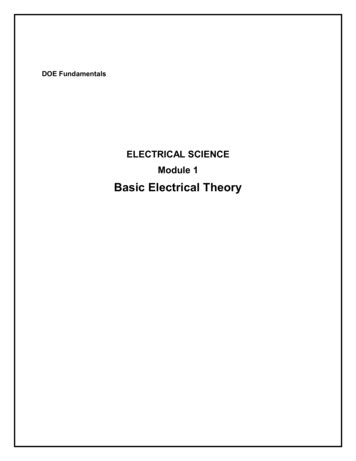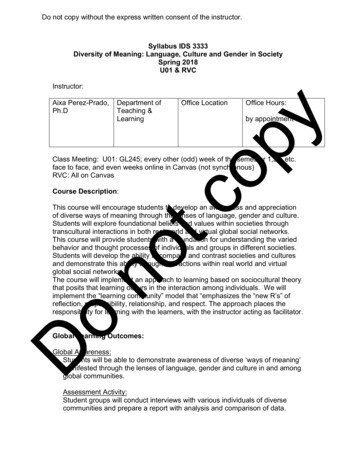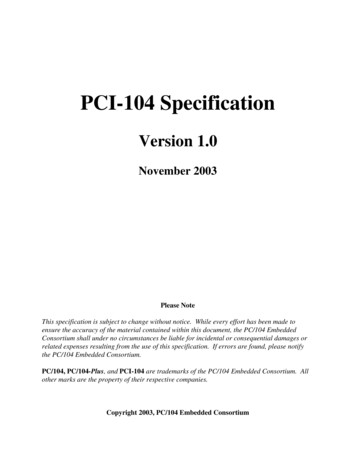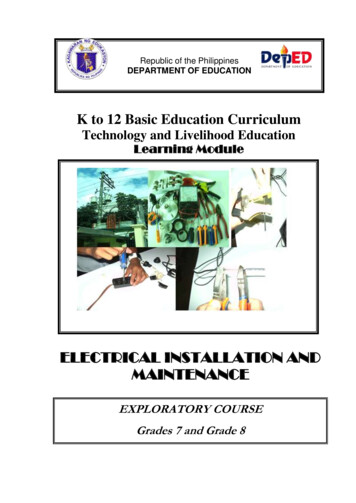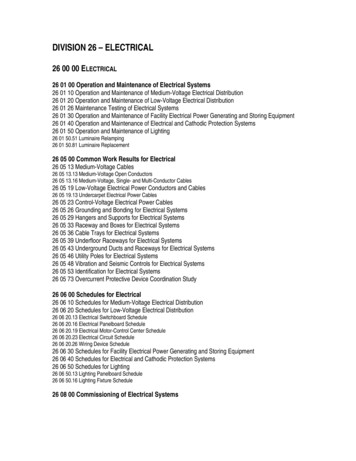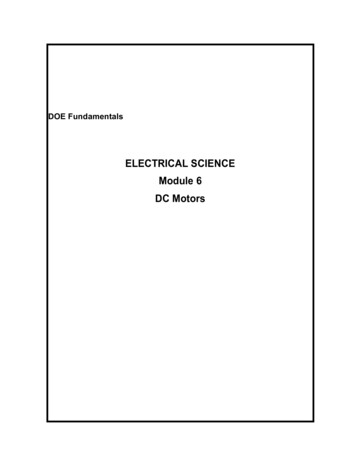
Transcription
DOE FundamentalsELECTRICAL SCIENCEModule 6DC Motors
Electrical ScienceDC MotorsTABLE OF CONTENTST able of Co nte ntsTABLE OF CONTENTS . iLIST OF FIGURES .iiLIST OF TABLES . iiiREFERENCES .ivOBJECTIVES . vDC MOTOR THEORY . 1Inducing a Force on a Conductor. 1Theory of Operation . 1Torque . 3Generator Action in a Motor . 5DC Motor Speed . 6Summary . 7TYPES OF DC MOTORS . 8DC Motor Connections . 8Shunt-Wound Motor Operation . 9Shunt-Wound Motor Applications . 9Series-Wound Motor . 10Series-Wound Motor Applications. 10Compounded Motor . 10Summary . 11DC MOTOR OPERATION . 12Starting of DC Motors . 12DC Motor Ratings . 13Summary . 14i
Electrical ScienceDC MotorsLIST OF FIGURESFigure 1Left-Hand Rule for Current-Carrying Conductors . 2Figure 2Current-Carrying Conductor in a Magnetic Field . 2Figure 3Motor Action . 3Figure 4Right-Hand Rule for Motors . 3Figure 5Armature Current in a Basic DC Motor . 4Figure 6Counterelectromotive Force (CEMF) . 5Figure 7DC Motor Connections . 8Figure 8Torque-vs-Speed for a Shunt-Wound DC Motor . 9Figure 9Torque-vs-Speed for a Series-Wound Motor . 10ii
Electrical ScienceDC MotorsLIST OF TABLESNONEiii
Electrical ScienceDC MotorsREFERENCES Gussow, Milton, Schaum's Outline of Basic Electricity, 2nd Edition, McGraw-Hill. Academic Program for Nuclear Power Plant Personnel, Volume I & II, Columbia,MD: General Physics Corporation, Library of Congress Card #A 326517, 1982. Nasar and Unnewehr, Electromechanics and Electric Machines, 2nd Edition, JohnWiley and Sons. Nooger and Neville Inc., Van Valkenburgh, Basic Electricity, Vol. 5, Hayden BookCompany. Lister, Eugene C., Electric Circuits and Machines, 5th Edition, McGraw-Hill. Mileaf, Harry, Electricity One - Seven, Revised 2nd Edition, Prentice Hall. Buban and Schmitt, Understanding Electricity and Electronics, 3rd Edition,McGraw-Hill Kidwell, Walter, Electrical Instruments and Measurements, McGraw-Hill.iv
Electrical ScienceDC MotorsOBJECTIVESTERMINAL OBJECTIVE1.0Given the type and application of a DC motor, DESCRIBE the operatingcharacteristics of that motor to include methods of speed variation, advantages ofeach type, and torque vs speed characteristics.ENABLING OBJECTIVES1.1Using the right-hand rule for motors, DETERMINE the direction of the magneticfield, direction of current flow, or force on a conductor.1.2STATE the function of torque in a direct current motor and how it is developed.1.3DESCRIBE how Counterelectromotive Force (CEMF) is developed in a DCmotor.1.4DESCRIBE the relationship between field current and magnetic field size in a DCmotor.1.5STATE the function of the CEMF that is developed in a DC motor.1.6DESCRIBE how the speed of a DC motor is adjusted.1.7DESCRIBE the relationship between armature current and torque produced in aDC motor.1.8DESCRIBE the differences in construction between a shunt-wound and a serieswound DC motor with respect to the relationship between the field and thearmature windings.1.9DESCRIBE the construction of a compounded DC motor.1.10DESCRIBE the torque-vs-speed characteristics for a shunt-wound and a serieswound DC motor.1.11EXPLAIN why starting resistors are necessary for large DC motors.1.12LIST the four nameplate ratings for a DC motor.v
Electrical ScienceDC MotorsDC Motor TheoryDC MOTOR THEORYDC motors are widely used to drive various equipment. The speed andtorque produced in a DC motor depends on a variety of factors.EO 1.1Using the right-hand rule for motors, DETERMINE the direction ofthe magnetic field, direction of current flow, or force on a conductor.EO 1.2STATE the function of torque in a direct current motor and how it isdeveloped.EO 1.3DESCRIBE how Counterelectromotive Force (CEMF) is developedin a DC motor.EO 1.4DESCRIBE the relationship between field current and magneticfield size in a DC motor.EO 1.5STATE the function of the CEMF that is developed in a DC motor.EO 1.6DESCRIBE how the speed of a DC motor is adjusted.EO 1.7DESCRIBE the relationship between armature current and torqueproduced in a DC motor.Inducing a Force on a ConductorThere are two conditions which are necessary to produce a force on a conductor. The conductor must be carrying current. The conductor must be within a magnetic field.When these two conditions exist, a force will be applied to the conductor, which willattempt to move the conductor in a direction perpendicular to the magnetic field. This isthe basic theory by which all DC motors operate.Theory of OperationEvery current-carrying conductor has a magneticfield around it. The direction of this magnetic fieldmay be found by using the left-hand rule forcurrent-carrying conductors. When the thumbpoints in the direction of current flow, the fingerswill point in the direction of the magnetic fieldproduced, as shown in Figure 1.Figure 1 Left-Hand Rule forCurrent-Carrying Conductors1
Electrical ScienceDC MotorsDC Motor TheoryIf a current-carrying conductor is placed in a magnetic field, the combined fields will besimilar to those shown in Figure 2. The direction of current flow through the conductor isindicated with an "x" or a ".". The "x" indicates the current flow is away from the reader,or into the page. The " " indicates the current flow is towards the reader, or out of thepage.Figure 2 Current-Carrying Conductor in a Magnetic FieldAbove the conductor on the left, the field caused by the conductor is in the oppositedirection of the main field, and therefore, opposes the main field. Below the conductoron the left, the field caused by the conductor is in the same direction as the main field,and therefore, aids the main field. The net result is that above the conductor the mainfield is weakened, or flux density is decreased; below the conductor the field isstrengthened, or flux density is increased. A force is developed on the conductor thatmoves the conductor in the direction of the weakened field (upward).Above the conductor on the right, the field caused by the conductor is in the samedirection as the main field, and therefore, aids the main field. Below the conductor onthe right, the field caused by the conductor is in the opposite direction of the main field,and therefore, opposes the main field. Thenet result is that above the conductor thefield is strengthened, or flux density isincreased, and below the conductor, thefield is weakened, or flux density isdecreased. A force is developed on theconductor that moves the conductor in thedirection of the weakened field (downward).In a DC motor, the conductor will be formedin a loop such that two parts of theconductor are in the magnetic field at thesame time, as shown in Figure 3.2
Electrical ScienceDC MotorsDC Motor TheoryThis combines the effects of both conductors to distort the main magnetic field andproduce a force on each part of the conductor. When the conductor is placed on a rotor,the force exerted on the conductors will cause the rotor to rotate clockwise, as shownon Figure 3.You can think of these magnetic lines of force as rubber bands that are always trying toshorten themselves. The lines of force above the conductor exert a downward force dueto the magnetic lines of force trying to straighten themselves.The above explanation of how aforce is developed is convenient;however, it is somewhat artificial. Itis based on a fundamental principleof physics which may be stated asfollows:"A current-carrying conductor in amagnetic field tends to move at rightangles to that field."Another important way to show therelationship between the currentcarrying conductor, magnetic field,and motion, is the right-hand rule formotors, as shown in Figure 4.The right-hand rule for motors shows the direction in which a current-carrying conductormoves in a magnetic field. When the forefinger is pointed in the direction of themagnetic field lines, and the center finger is pointed in the direction of current flow, thethumb will point in the direction of force (motion).TorqueTorque is defined as that force which tends to produce and maintain rotation. Thefunction of torque in a DC motor is to provide the mechanical output or drive the piece ofequipment that the DC motor is attached to.When a voltage is applied to a motor, current will flow through the field winding,establishing a magnetic field. Current will also flow through the armature winding, fromthe negative brush to the positive brush as shown in Figure 5.Since the armature is a current-carrying conductor in a magnetic field, the conductorhas a force exerted on it, tending to move it at right angles to that field. Using the lefthand rule for current-carrying conductors, you will see that the magnetic field on oneside is strengthened at the bottom, while it is weakened on the other side. Using the3
Electrical ScienceDC MotorsDC Motor Theoryright-hand rule for motors, we can see that there is a force exerted on the armaturewhich tends to turn the armature in the counter-clockwise direction. The sum of theforces, in pounds, multiplied by the radius of the armature, in feet, is equal to the torquedeveloped by the motor in pound-feet (lb - ft).It is evident from Figure 5 that if thearmature current was reversed, but the fieldwas the same, torque would be developedin the opposite direction. Likewise, if thefield polarity was reversed and thearmature remained the same, torque wouldalso be developed in the opposite direction.The force that is developed on a conductorof a motor armature is due to the combinedaction of the magnetic fields. The forcedeveloped is directly proportional to thestrength of the main field flux and thestrength of the field around the armatureconductor. As we know, the field strengtharound each armature conductor depends on the amount of current flowing through thearmature conductor. Therefore, the torque which is developed by the motor can bedetermined using Equation (6-1).T K Φ Ia(6-1)T torque, lb-ftK a constant depending on physical size of motorΦ field flux, number of lines of force per poleIa armature currentwhere4
Electrical ScienceDC MotorsDC Motor TheoryGenerator Action in a MotorA generator action is developed in everymotor. When a conductor cuts lines of force,an EMF is induced in that conductor.Current to start the armature turning willflow in the direction determined by theapplied DC power source. After rotationstarts, the conductor cuts lines of force. Byapplying the left-hand rule for generators,the EMF that is induced in the armature willproduce a current in the opposite direction.The induced EMF, as a result of motoroperation, is called counterelectromotiveforce, or CEMF, as illustrated in Figure 6.Figure 6 Counterelectromotive Force(CEMF)Since the CEMF is generated by the action of the armature cutting lines of force, thevalue of CEMF will depend on field strength and armature speed, as shown in Equation(6-2).ECEMF KΦN(6-2)ECEMF counter EMFK constantΦ field flux strengthN speed of the armaturewhereThe CEMF opposes the applied voltage and functions to lower armature current. Theeffective voltage acting in the armature of a motor is the applied voltage, minus thecounter EMF. Armature current can be found by using Ohm's law, as shown in Equation(6-3).Ia IaEtECEMFRa Et - ECEMFRa(6-3)wherearmature currentterminal voltagecounter EMFarmature resistance5
Electrical ScienceDC MotorsDC Motor TheoryDC Motor SpeedThe field of a DC motor is varied using external devices, usually field resistors. For aconstant applied voltage to the field (E), as the resistance of the field (Rf) is lowered, theamount of current flow through the field (I f) increases as shown by Ohm's law inEquation (6-4).(6-4)An increase in field current will cause field flux (Φf) to increase. Conversely, if theresistance of the field is increased, field flux will decrease. If the field flux of a DC motoris decreased, the motor speed will increase. The reduction of field strength reduces theCEMF of the motor, since fewer lines of flux are being cut by the armature conductors,as shown in Equation (6-5).(6-5)A reduction of counter EMF allows an increase in armature current as shown inEquation (6-6).(6-6)This increase in armature current causes a larger torque to be developed; the increasein armature current more than offsets the decrease in field flux as shown in Equation (67).(6-7)This increased torque causes the motor to increase in speed.6
Electrical ScienceDC MotorsDC Motor TheoryThis increase in speed will then proportionately increase the CEMF. The speed andCEMF will continue to increase until the armature current and torque are reduced tovalues just large enough to supply the load at a new constant speed.SummaryDC motor theory is summarized below.DC Motor Theory Summary There are two conditions necessary to produce a force on a conductor:o The conductor must be carrying current.o The conductor must be within a magnetic field. The right-hand rule for motors states that when the forefinger is pointed in thedirection of the magnetic field lines, and the center finger is pointed in thedirection of current flow, the thumb will point in the direction of motion. The function of torque in a DC motor is to provide the mechanical output to drivethe piece of equipment that the DC motor is attached to. Torque is developed in a DC motor by the armature (current-carrying conductor)being present in the motor field (magnetic field). CEMF is developed in a DC motor by the armature (conductor) rotating (relativemotion) in the field of the motor (magnetic field). The function of the voltage that is developed in a DC motor (CEMF) opposesthe applied voltage and results in the lowering of armature current. The speed of a DC motor may be changed by using resistors to vary the fieldcurrent and, therefore, the field strength.7
Electrical ScienceDC MotorsTypes of DC MotorsTYPES OF DC MOTORSThere are various types of DC motors found in industry today. Each typecontains various characteristics that makes it desirable for certainapplications.EO 1.8DESCRIBE the differences in construction between a shunt-woundand a series-wound DC motor with respect to the relationshipbetween the field and the armature windings.EO 1.9DESCRIBE the construction of a compounded DC motor.EO 1.10DESCRIBE the torque-vs-speed characteristics for a shunt-woundand a series-wound DC motor.DC Motor ConnectionsFigure 7 shows schematically the different methodsof connecting the field andarmature circuits in a DCmotor. The circular symbolrepresents the armaturecircuit, and the squares atthe side of the circlerepresent the brushcommutator system. Thedirection of the arrowsindicates the direction ofthe magnetic fields.Figure 7 DC Motor Connections Figure 7a shows an externally-excited DC motor. This type of DC motor isconstructed such that the field is not connected to the armature. This type of DCmotor is not normally used. Figure 7b shows a shunt DC motor. The motor is called a "shunt" motor becausethe field is in parallel, or "shunts" the armature.8
Electrical ScienceDC MotorsTypes of DC Motors Figure 7c shows a series DC motor. The motor field windings for a series motorare in series with the armature. Figures 7d and 7e show a compounded DC motor. A compounded DC motor isconstructed so that it contains both a shunt and a series field. Figure 7d is calleda "cumulatively-compounded" DC motor because the shunt and series fields areaiding one another. Figure 7e is called a "differentially-compounded" DC motorbecause the shunt and series field oppose one another.Shunt-Wound Motor OperationThe speed-torque relationshipfor a typical shunt-wound motoris shown in Figure 8.A shunt-wound DC motor has adecreasing torque when speedincreases. The decreasingtorque-vs-speed is caused bythe armature resistance voltagedrop and armature reaction. Ata value of speed near 2.5 timesthe rated speed, armaturereaction becomes excessive,causing a rapid decrease infield flux, and a rapid decline intorque until a stall condition isreached.Shunt-Wound Motor ApplicationsThe characteristics of a shunt-wound motor give it very good speed regulation, and it isclassified as a constant speed motor, even though the speed does slightly decrease asload is increased. Shunt-wound motors are used in industrial and automotiveapplications where precise control of speed and torque are required.9
Electrical ScienceDC MotorsTypes of DC MotorsSeries-Wound MotorSince the armature and field in aseries-wound motor areconnected in series, the armatureand field currents becomeidentical, and the torque can beexpressed as shown in Equation(6-8).(6-8)The torque-vs-speedcharacteristics of a series-woundmotor with a constant voltagesource are shown in Figure 9. As the speed decreases, the torque for a series-woundmotor increases sharply. As load is removed from a series motor, the speed willincrease sharply. For these reasons, series-wound motors must have a load connectedto prevent damage from high speed conditions.Series-Wound Motor ApplicationsThe advantage of a series-wound motor is that it develops a large torque and can beoperated at low speed. It is a motor that is well-suited for starting heavy loads; it is oftenused for industrial cranes and winches where very heavy loads must be moved slowlyand lighter loads moved more rapidly.Compounded MotorThe compounded motor is desirable for a variety of applications because it combinesthe characteristics of a series-wound motor and a shunt-wound motor. Thecompounded motor has a greater torque than a shunt motor due to the series field;however, it has a fairly constant speed due to the shunt field winding. Loads such aspresses, shears, and reciprocating machines are often driven by compounded motors.10
Electrical ScienceDC MotorsTypes of DC MotorsSummaryThe types of DC motors are summarized below.Types of DC Motors Summary In a shunt-wound motor, the field is in parallel, or "shunts" the armature. In a series-wound motor, the field is in series with the armature. A compounded DC motor is constructed so that it contains both a shunt and aseries field. A shunt-wound DC motor has a decreasing torque as speed increases. The characteristics of a shunt-wound motor give it very good speed regulation,and it is classified as a constant speed motor, even though the speed doesslightly decrease as load is increased. A series-wound motor has a rapidly increasing torque when speed decreases.As load is removed from a series-wound motor, the speed will increase sharply. The advantages of a series-wound motor are that it develops a large torque andcan be operated at low speed. It is a motor that is well-suited for starting heavyloads.11
Electrical ScienceDC MotorsDC Motor OperationDC MOTOR OPERATIONDC motors require special starting resistors for operation due to theirunique design. Knowledge of the operation of these starting resistors isnecessary to understand DC motor operation.EO 1.11EXPLAIN why starting resistors are necessary for large DC motors.EO 1.12LIST the four nameplate ratings for a DC motor.Starting of DC MotorsAt the moment a DC motor is started the armature is stationary and there is no counterEMF being generated. The only component to limit starting current is the armatureresistance, which, in most DC motors is a very low value (approximately one ohm orless), as shown in Equation (6-9).(6-9)In order to reduce this very high starting current, an external resistance must be placedin series with the armature during the starting period. To show why this is essential, letus consider a 10-hp motor with an armature resistance of 0.4 ohms. If the motor weresupplied by a 260 VDC source, the resulting current would be as shown in Equation (69).This large current is approximately twelve times greater than actual full-load current forthis motor. This high current would, in all probability, cause severe damage to thebrushes, commutator, or windings. Starting resistors are usually incorporated into themotor design to limit starting current to 125 to 200 percent of full load current.12
Electrical ScienceDC MotorsDC Motor OperationThe amount of starting resistance necessary to limit starting current to a more desirablevalue is calculated using Equation (6-10.RsEtIsI where- Ra(6-10)Rs Et starting resistanceaterminal voltageIs desired armature starting currentRa armature resistanceExample:If the full load current of the motor mentioned previously is 50 amps, and itis desired to limit starting current to 125% of this value, find the requiredresistance that must be added in series with the armature.The starting resistors are used in a DC motor by placing them in the starting circuit ofthe motor controller that is used to start the DC motor. Starting resistors are normally ofvariable resistances, with the value of resistance in the circuit at any time being eithermanually or automatically controlled. The maximum amount of resistance will always beinserted when the motor is first started. As the speed of the motor increases, counterEMF will begin to increase, decreasing armature current. The starting resistors maythen be cut out, in successive steps, until the motor reaches full running speed.DC Motor RatingsThe nameplate ratings of a DC motor refer to the conditions of voltage, current, speed,and power at which the motor is normally operated. The principal rating is known as thecontinuous rating, which is the rating described on the nameplate of a motor. Thecontinuous power rating is a thermal rating. At this power, the motor can be operated forlong periods of time without a large rise in temperature and beyond the limits of theconductor insulating material, bearings and other components, which are greatlyaffected by temperature.13
Electrical ScienceDC MotorsDC Motor OperationSummaryDC motor operation is summarized below.DC Motor Operation Summary Starting resistors are necessary for large DC motors to prevent damage due tohigh currents while starting the motor. Starting resistors are placed in the starting circuits for the controllers that startthe motor. When the motor reaches full speed, the starting resistors are cut outof the circuit. The four nameplate ratings for a DC motor include:o voltageo currento speedo power14
is based on a fundamental principle of physics which may be stated as follows: "A current-carrying conductor in a magnetic field tends to move at right angles to that field." Another important way to show the relationship between the current-carrying conductor, magnetic field, and motion,





